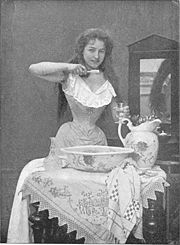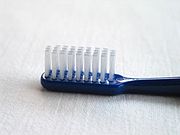
Tooth brushing
Encyclopedia

Toothbrush
The toothbrush is an oral hygiene instrument used to clean the teeth and gums that consists of a head of tightly clustered bristles mounted on a handle, which facilitates the cleansing of hard-to-reach areas of the mouth. Toothpaste, which often contains fluoride, is commonly used in conjunction...
.
Modern medical research has shown that brushing teeth properly can prevent cavities, and periodontal, or gum disease, which causes at least one-third of adult tooth loss
Tooth loss
Tooth loss is when one or more teeth come loose and fall out. Tooth loss is normal for deciduous teeth , when they are replaced by a person's adult teeth. Otherwise, losing teeth is undesirable and is the result of injury or disease, such as mouth trauma, tooth injury, tooth decay, and gum disease...
. If teeth are not brushed correctly and frequently, it could lead to the calcification of saliva minerals, forming tartar
Calculus (dental)
In dentistry, calculus or tartar is a form of hardened dental plaque. It is caused by the continual accumulation of minerals from saliva on plaque on the teeth...
. Poor dental health has been associated with heart disease and shortened life expectancy.
Brushing one's teeth has long been considered an important part of dental care
Dental care
Dental care is the maintenance of healthy teeth. Forms include:* Oral hygiene, the practice of keeping the mouth and teeth clean in order to prevent cavities , gum disease, and other dental disorders....
. As long ago as 3000 BC ancient Egyptians constructed crude toothbrushes from twigs and leaves to clean their teeth. Similarly, other cultures such as the Greeks, Romans, and Indians cleaned their teeth with twigs. Some would fray one end of the twig so that it could penetrate between the teeth more effectively.
Modern day toothbrushing as a regular habit became prevalent in Europe from the end of the 17th century. The first mass-produced toothbrush was developed in England in 1780. In the United States, although toothbrushes were available at the end of the 19th century, the practice did not become widespread until after the Second World War
World War II
World War II, or the Second World War , was a global conflict lasting from 1939 to 1945, involving most of the world's nations—including all of the great powers—eventually forming two opposing military alliances: the Allies and the Axis...
, when US soldiers continued the toothbrushing that had been required during their military service.
Toothbrush

Toothbrush
The toothbrush is an oral hygiene instrument used to clean the teeth and gums that consists of a head of tightly clustered bristles mounted on a handle, which facilitates the cleansing of hard-to-reach areas of the mouth. Toothpaste, which often contains fluoride, is commonly used in conjunction...
is an instrument used to clean teeth, consisting of a small brush
Brush
A brush is a tool with bristles, wire or other filaments, used for cleaning, grooming hair, make up, painting, surface finishing and for many other purposes. It is one of the most basic and versatile tools known to mankind, and the average household may contain several dozen varieties...
on a handle. Toothpaste
Toothpaste
Toothpaste is a paste or gel dentifrice used with a toothbrush as an accessory to clean and maintain the aesthetics and health of teeth. Toothpaste is used to promote oral hygiene: it serves as an abrasive that aids in removing the dental plaque and food from the teeth, assists in suppressing...
, often containing fluoride
Fluoride
Fluoride is the anion F−, the reduced form of fluorine when as an ion and when bonded to another element. Both organofluorine compounds and inorganic fluorine containing compounds are called fluorides. Fluoride, like other halides, is a monovalent ion . Its compounds often have properties that are...
, is commonly added to a toothbrush to aid in cleaning. Toothbrushes are offered with varying textures of bristles, and come in many different sizes and forms. Most dentist
Dentist
A dentist, also known as a 'dental surgeon', is a doctor that specializes in the diagnosis, prevention, and treatment of diseases and conditions of the oral cavity. The dentist's supporting team aides in providing oral health services...
s recommend using a toothbrush labelled "Soft", since firmer bristled toothbrushes can damage tooth enamel
Tooth enamel
Tooth enamel, along with dentin, cementum, and dental pulp is one of the four major tissues that make up the tooth in vertebrates. It is the hardest and most highly mineralized substance in the human body. Tooth enamel is also found in the dermal denticles of sharks...
and irritate gums
Gingiva
The gingiva , or gums, consists of the mucosal tissue that lies over the mandible and maxilla inside the mouth.-General description:...
as indicated by the American Dental Association
American Dental Association
The American Dental Association is an American professional association established in 1859 which has more than 155,000 members. Based in Chicago, the ADA is the world's largest and oldest national dental association and promotes good oral health to the public while representing the dental...
. Toothbrushes are often made from synthetic fiber
Synthetic fiber
Synthetic fibers are the result of extensive research by scientists to improve on naturally occurring animal and plant fibers. In general, synthetic fibers are created by forcing, usually through extrusion, fiber forming materials through holes into the air, forming a thread...
s, although natural toothbrushes are also known in many parts of the world. Those with dentures
Dentures
Dentures are prosthetic devices constructed to replace missing teeth, and which are supported by surrounding soft and hard tissues of the oral cavity. Conventional dentures are removable, however there are many different denture designs, some which rely on bonding or clasping onto teeth or dental...
may also brush their teeth with traditional tooth brushes, specially made denture brushes or denture cleaner
Denture cleaner
Denture Cleaner, also known as denture cleanser, is a cleaner used to assist in denture cleaning. Chemical denture cleaners can come in cream, liquid, powder or tablet format. Some chemical denture cleaners are effervescent and others are not...
s.
Toothpaste

Toothpaste
Toothpaste is a paste or gel dentifrice used with a toothbrush as an accessory to clean and maintain the aesthetics and health of teeth. Toothpaste is used to promote oral hygiene: it serves as an abrasive that aids in removing the dental plaque and food from the teeth, assists in suppressing...
is a paste or gel
Gel
A gel is a solid, jelly-like material that can have properties ranging from soft and weak to hard and tough. Gels are defined as a substantially dilute cross-linked system, which exhibits no flow when in the steady-state...
dentifrice
Dentifrice
Dentifrice is a paste, liquid or powder used to help maintain oral hygiene. There have been many dentifrices produced over the years, many focusing on marketing strategies to sell products, such as offering whitening capabilities. The most essential dentifrice recommended by dentists is toothpaste...
used to clean and improve the aesthetic appearance and health of teeth. It is almost always used in conjunction with a toothbrush
Toothbrush
The toothbrush is an oral hygiene instrument used to clean the teeth and gums that consists of a head of tightly clustered bristles mounted on a handle, which facilitates the cleansing of hard-to-reach areas of the mouth. Toothpaste, which often contains fluoride, is commonly used in conjunction...
. Toothpaste use can promote good oral hygiene
Oral hygiene
Teeth cleaning is part of oral hygiene and involves the removal of dental plaque from teeth with the intention of preventing cavities , gingivitis, and periodontal disease. People routinely clean their own teeth by brushing and interdental cleaning, and dental hygienists can remove hardened...
: it can aid in the removal of dental plaque
Dental plaque
Dental plaque is a biofilm, usually a pale yellow, that develops naturally on the teeth. Like any biofilm, dental plaque is formed by colonizing bacteria trying to attach themselves to a smooth surface...
and food
Food
Food is any substance consumed to provide nutritional support for the body. It is usually of plant or animal origin, and contains essential nutrients, such as carbohydrates, fats, proteins, vitamins, or minerals...
from the teeth, it can aid in the elimination and/or masking of halitosis
Halitosis
Halitosis is a term used to describe noticeably unpleasant odors exhaled in breathing. Halitosis is estimated to be the third most frequent reason for seeking dental aid, following tooth decay and periodontal disease.- General :...
, and it can deliver active ingredients such as fluoride
Fluoride
Fluoride is the anion F−, the reduced form of fluorine when as an ion and when bonded to another element. Both organofluorine compounds and inorganic fluorine containing compounds are called fluorides. Fluoride, like other halides, is a monovalent ion . Its compounds often have properties that are...
to prevent tooth and gum (Gingiva
Gingiva
The gingiva , or gums, consists of the mucosal tissue that lies over the mandible and maxilla inside the mouth.-General description:...
) disease.
Tooth powder
Tooth powder (or 'toothpaste powder') is an alternative to toothpaste. It may be recommended for people with sensitive teeth. Tooth powder typically does not contain the chemical sodium lauryl sulphate which can be a skin irritant. The function of sodium lauryl sulphate is to form suds when teeth are brushed. It is a common chemical in toothpaste. Those with dentures may also use denture cleaner which can also come in powder format.See also
- Teeth cleaning
- Dental careDental careDental care is the maintenance of healthy teeth. Forms include:* Oral hygiene, the practice of keeping the mouth and teeth clean in order to prevent cavities , gum disease, and other dental disorders....
- Smiley's Good Teeth Puppet Theatre

